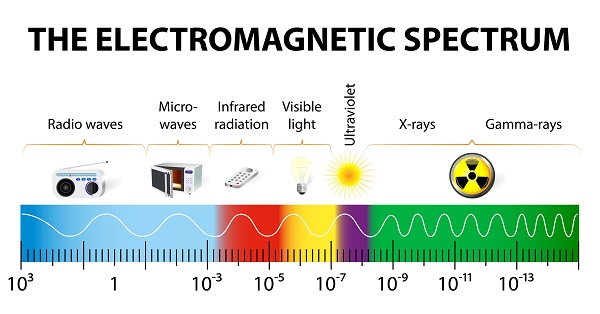Do you see where the “visible light” rainbow section is in the electromagnetic spectrum image below? This small area shows the light that you can actually see with your eyeballs. Note that the “rainbow of colors” that make up our entire visible world only make up a small part of all the light, from 400-700 nm (nanometers, or 10-9.
[am4show have=’p9;p58;’ guest_error=’Guest error message’ user_error=’User error message’ ]

Each color corresponds to a particular wavelength within the visible light spectrum. When that wavelength hits your eye, you perceive a particular color.
Red has the longest wavelengths (closer to 400 nm) and violet has the highest frequencies (closer to 700nm). UV (ultra-violet) light is invisible, which means you can’t see it with just your eyes. Our sun gives off light in the UV. Too much exposure to the sun and you’ll get a sunburn from the UV rays.
UV sensitive materials have a pigment inside that changes color when exposed to UV light from either the sun or lights that emit in the 350nm – 300nm wavelength. If you have fluorescent black lights, use them. (Do regular incandescent bulbs work? If not, you know they emit light outside the range of the beads!)
UVA waves are the longest of the UV waves, and you’ll find them in black lights. These are not absorbed by the ozone layer. Their frequency wavelength ranges from 315-400nm.
UVB waves are is medium energy waves, mostly absorbed by the ozone layer and have a range between 315-280nm). UVC are the shortest, highest energy UV waves that are used to kill germs, and they are completely absorbed by the atmosphere and the ozone layers.
On the other end of the visible spectrum of visible light is infrared light. Infra-red light is in the part of the electromagnetic spectrum that isn’t usually visible to human eyes, but using this nifty trick, you will easily be able to see the IR signal from your TV remote, remote-controller for an RC car.
Click here to go to next lesson on Cold Light Mixing
[/am4show]

Oh gosh – I am ao sorry for the typos! I’ve re-written this section so it’s accurate and added a bit about UVC. Thank you for your eagle eye!
UVA is between 315-400nm, and UVB is 280-315nm, UVC is 100-280nm.
We’re wondering about UVA vs UVB – the text above states that “UVA is high energy” and “UVB is low-energy.” However, elsewhere we’ve learned that longer wavelengths have a lower frequency, and lower energy. Since UVA waves are longer than UVB waves, shouldn’t that mean that UVA is lower energy than UVB?